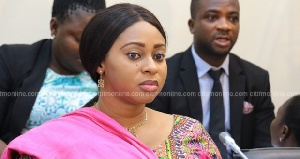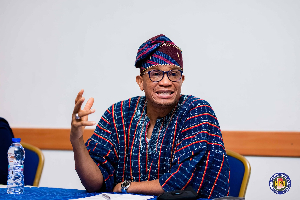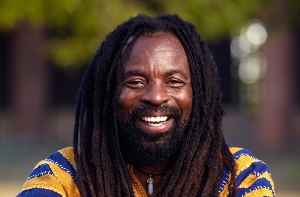Society, has prescribed a code of conduct for pastor’s children, but the daughter of Apostle Dr. Kwadwo Safo Kantanka; founder of the Kristo Asafo Church, Sarah Adwoa Safo, who is the Member of Parliament (MP) for Dome-Kwabenya Constituency in the Greater Accra Region, appears to have developed her own code which includes peddling untruths.
Adwoa Safo popularly called “Osofoba Adwoa” (Pastor’s child) has stirred social media controversy, following her blatant untruth that the Community Day School built in her Constituency was done through her connections inside the World Bank, and had nothing to do with the Mahama government as widely held.
In a 1:25 seconds video, the Deputy Majority Leader, is heard telling his party members during a Constituency meeting in one of the classrooms, that it was through her sweat, hard work and connections in America, which secured the facility from the World Bank.
The MP who is the Minister of Public Procurement in the Akufo-Addo government, falsely insisted she only had to look for a parcel of land to enable her friends at the World Bank put up the secondary school; the first of its kind in the Dome-Kwabenya Constituency.
“Osofoba Adwoa” earned tremendous applause from her ignorant audience at the event, while sweating profusely and feeling uncomfortable as she defies Proverbs 12:22 – “The LORD detests lying lips, but He delights in people who are trustworthy”.
Meanwhile, a former deputy Minister for Education, Samuel Okudzato Ablakwa, has put the break on his colleague in Parliament with a rebuttal setting the records straight.
According to the North Tongu MP, every activity concerning the building of the 200 schools, including the acquisition of land which includes Dome-Kwabenya, were initiated by the ministry under the leadership of then Education Minister, Jane Naana Opoku Agyeman and the beneficiary assemblies.
He said, “Under the dynamic and able leadership of Prof. Naana Jane Opoku-Agyemang, the Minister for Education who President Mahama appointed to oversee the Education sector and actualize his vision, the Ministry of Education carried out the following activities for the new construction: Prepared criteria for selecting Districts and towns to benefit from the project.
Prepared the Programmes to be offered in schools at each of the selected districts. Determined the optimum size of land needed to run the various Programmes and secured all land through the various District Assemblies needed for the new schools, including land for the Dome Kwabenya project”.
As if by design, the two times lawmaker, while busily telling an obvious lie, had to intermittently clean her face with her white handkerchief, because she was sweating profusely.
According to her, though the New Patriotic Party (NPP) was in opposition at the time and so getting such an opportunity was rare, she managed to convince the World Bank, which was going to finance part of the government’s 200 Community Day Senior High Schools (SHS) project popularly known as E-Block.
Ms Safo, said it was not true that, the then governing National Democratic Congress (NDC) government led by president John Mahama, built the school because all the schools it built, were in the stronghold of the government.
“I will go ahead and mention one or two things. As we were in opposition as your Member of Parliament (MP) though things were rough, but we managed to do one or two things which I want to list.
The first is the facility we are sitting in, the secondary school that today, Dome-Kwabenya, have benefitted.
If you look at this big Constituency, we had no secondary school, but due to my hard work at the Committee level in Parliament, it so happened that the World Bank from Washington DC which I had worked with before were making some funds available to government to build secondary schools.
I discussed with them and the World Bank told me, if I can get a land free of dispute, they will give me one of the schools. The NDC built all the secondary schools in their strongholds and that tells you that it is not coming from their government”, she ended with applauds from the party supporters.
It is on record that the Community Day School project was spread across the country and it did not matter whether beneficiary community was the stronghold of the government or the opposition at the time.
In Ashanti Region for instance, which is the stronghold of the NPP, a total of 13 of such projects were ongoing for the first phase and were at different stages of completion before the NDC government exited power.
The 200 Community Day Senior High School project was one of President Mahama’s flagship campaign programmes for the 2012 general elections. It was initially solely funded by the Government of Ghana (GoG) but later, Ghana got a 156million dollar credit from the World Bank under the Secondary Education Improvement Project (SEIP).
The SEIP credit facility was the same facility that the NPP christened; the Sanitary Pad Loan. Only 23 of the Community Day School programme were built by the Bank.
It will be recalled that, ahead of the 2016 elections, The Herald published stories of NPP MPs, who were laying claims to president Mahama’s projects in their various constituencies.
Ms Safo, who was one of them, campaigned vigorously with this project in addition to several other works by the government.
Some other female MPs who felt too proud to give credit to the government were now Minister for Communications, Ursula Gifty Ekuful-Owusu, and Awutu Senya East MP, Hawa Koomson, who is also a Minister.
Some of these projects were; the Dome market, roads, and water projects etc. On the day of commissioning the Day School last year by president Mahama, the MP, was nowhere to be found.
Below is the full statement by the former deputy Minister, Samuel Okudzeto Ablakwa…..
THE HON. SARAH ADWOA SAFO VIDEO – SETTING THE RECORD STRAIGHT
My attention has been drawn to a video which captures the Member of Parliament for Dome/Kwabenya, Deputy Majority Leader and Minister of State at the Presidency in charge of Public Procurement, the Hon. Sarah Adwoa Safo claiming in the said video that the Community Senior High School constructed and commissioned in her constituency during the tenure of President John Dramani Mahama was as a result of her personal intervention with the World Bank, that the Senior High School was not from the then NDC Government and that with the exception of the Dome/Kwabenya Senior High School project, all the other schools constructed during the previous NDC administration were executed in NDC strongholds.
As Deputy Minister who served at the Ministry of Education when these iconic President Mahama flagship schools were constructed, and considering the avalanche of calls from the media seeking clarification and a reaction from me to the video in issue, I wish to set the record straight as follows:
Background
President John Dramani Mahama promised during the 2012 electioneering campaign to construct some 200 Community Day Senior High Schools when elected.
Under the dynamic and able leadership of Prof. Naana Jane Opoku-Agyemang, the Minister for Education who President Mahama appointed to oversee the Education sector and actualize his vision, the Ministry of Education carried out the following activities for the new construction:
1) Prepared criteria for selecting Districts and towns to benefit from the project.
2) Prepared the Programmes to be offered in Schools at each of the selected Districts.
3) Determined the optimum size of land needed to run the various Programmes and secured all land through the various District Assemblies needed for the new schools including land for the Dome Kwabenya project.
4) Carried out Case Studies of existing Schools.
5) Determined the structures necessary to run the various Programmes.
6) Designed the various structures by taking into consideration the Employer’s Brief and ways of making the designs attractive but very cost effective.
7) Prepared a costing of the structures designed.
8) Decided on how to phase the project implementation.
District selection criteria
The following criteria were used to select Districts that would benefit from the programme:
(a) All the 46 new districts that were established in 2012 except those that already have public Senior High Schools
(b) All other districts that do not have public Senior High Schools.
(c) Districts that have very high Junior High School enrolments than available schools can accommodate.
It should be noted that when we settled on the criteria above, it was established that apparently, there were 23 Districts in Ghana without a Senior High School and this included Ga East Municipal which hosts the Dome/Kwabenya constituency.
Clearly, an objective and fair criteria was pursued by the NDC Government in selecting beneficiary Districts. President Mahama was President for all of Ghana including the Dome/Kwabenya constituency and NOT just NDC strongholds.
Designs
Designs for the following structures inter alia were prepared:
Security and Gate House 4-storey 24-unit Classroom Block (E-Block) Technical/Vocational Block Canteen Block 3-Bedroom School Head’s Bungalow with 2-bedroom Outhouse 4-storey Block of 8 No. 2-Bedroom Staff Flats
Owing to funding constraints, Government decided to start the project by constructing an E-Block in each beneficiary District except the 23 World Bank funded projects which came with the full complement after successful negotiations led by Prof. Naana Jane Opoku-Agyemang. The other structures would be added on as future phases of the project. Each school was expected to cater for 1,080 students when it is fully operational with a contract completion period of 18 months from the contract start date.
The E-Block is a 4-level E-shaped structure with three fingers measuring 30.15m x10.75m; 32.55m x 9.80m; 32.55m x 9.80m and a stem measuring 54.00m x 8.65m on plan. The overall height of the structure is 16.55m. The E-Block has space for 24 Classrooms; 4 Laboratories (Integrated Science; Physics; Chemistry; Biology); 2 Libraries; 8 Offices for Departmental Heads; ICT Laboratories software/hardware and Internet Learning area.
World Bank Support
President John Dramani Mahama approached the World Bank to support his vision for Secondary Education in Ghana. This proposal received favourable response with Minister of Education, Prof. Naana Jane Opoku-Agyemang leading a delegation that comprised Hon. Alex Kyeremeh (Deputy Minister, Pre-Tertiary), Enoch Cobbinah (Chief Director) and other technical staff of the Ministry to the World Bank Headquarters in Washington, D.C., United States of America to negotiate a $156 million facility for what became known as the Ghana Secondary Education Improvement Project (SEIP)
The Secondary Education Improvement Project was approved by the World Bank Board on May 20, 2014 for an amount of US$156 million (IDA), signed on July 30, 2014, declared effective on October 3, 2014, and launched on November 4, 2014 by President John Dramani Mahama. The project was restructured on August 30, 2016 to ensure reallocation among disbursement categories and revise the percentage of expenditures to be financed for all categories up to 100% financing. This was to allow more flexibility in project implementation and to ensure that activities are not held back given the results-based nature of the project.
The Project Development Objective is to increase access to senior secondary education in underserved districts and improve quality in low-performing senior high schools (SHSs) in Ghana. This is a five-year IPF closing on November 30, 2019. It uses a results based financing approach under the first component which aims to increase access with equity and quality in SHSs. Component One comprises Pillar 1 and 2 as follows:
The first results area (Pillar 1) aims to expand senior secondary places through the construction of 23 new SHS in underserved districts including Dome Kwabenya; rehabilitate and expand 50 existing low performing SHSs and support attainment of disadvantaged students (e.g., through scholarships to 10,400 students from low income families, especially girls).
The second results area (Pillar 2) focuses on improving the quality of education in 125 selected low-performing SHS through: (i) strengthened school management and accountability; (ii) improved mathematics and science teaching and learning; (iii) expanded information, communication technology and internet connectivity in schools; and (iv) the implementation of school performance partnership plans. Component Two uses a traditional investment approach to finance technical assistance, management, research and monitoring and evaluation for effective project implementation.
I shall now provide below, a tabular guide of project locations under the various phases including the World Bank funded projects which do not and cannot support the assertion by the Hon. Sarah Adwoa Safo that the Community Senior High Schools were constructed in only NDC strong holds.
SITES OF 50 CONTRACTS AWARDED UNDER PHASE I OF CSHSP
Region District Location
Ashanti Obuasi Municipal Kwanenakwa
Ashanti Adansi North Fumso
Ashanti Bosumtwe Oyoko
General News of Friday, 7 July 2017
Source: theheraldghana.com

















